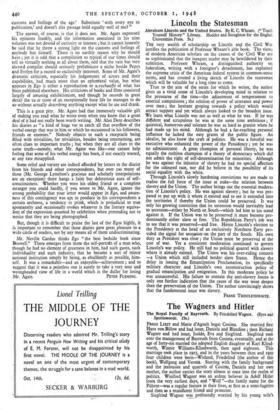The Wagners and Hitler
The Royal Family of Bayreuth. By Friedelind Wagner. (Eyre and Spottiswoode. 15s.) The Royal Family of Bayreuth. By Friedelind Wagner. (Eyre and Spottiswoode. 15s.) FRANZ LISZT and Marie d'Agoult begat Cosima. She married first Hans von Billow and had issue, Daniela and Blandine ; then Richard Wagner and had issue, Isolde, Eva and Siegfried. Siegfried took over the management of Bayreuth from Cosima, eventually, and at the age of forty-six married the adopted English daughter of Karl Klind- worth, Winnie Williams-Klindworth, then aged eighteen. This marriage took place in 1915, and in the years between then and 19zo four children were born—Wieland, Friedelind (the author of this book), Wolfgang and Verena. Starting with the family background and the jealousies and quarrels of Cosima, Daniela and her own mother, the author carries the story almost at once into the realm of politics. Winifred Wagner was an ardent believer in Adolf Hider from the very earliest days, and " Wolf "—the family name for the Filluer—was a regular feature in their lives, at first as a semi-fugitive and then as a munificent friend and protector.
Siegfried Wagner was profoundly worried by his young wife's political sympathies, though he died in 1930 before their full impli- cations had become plain. Friedelind seems to have been his favourite daughter, and she adored this genial, charming man with the cosmopolitan background and the list of eccentrically-named operas to his credit. (Their names are probably the most interesting things about them.) With her mother, perhaps for this very obvious reason, she never for a moment got on, and this simple family circumstance may explain the fact that she alone found Germany and the personal patronage of the Fiihrer unbearable and escaped in the early years of the war to America, apparently cutting all ties with her family. ---
Music-loveri will be faStinated by the inside account of the last chapter of the Liszt-Wagner saga and the- musical gossip about famous singers and conductors of which Bayreuth was inevitably a centre. Those with less musical interests will be attracted by the picture of the Fiihrer and the top-ranking Nazis, seen always at their most ingratiating and speaking and acting " off the record." But the real dramatic quality of the story is centred in the figure of Winifred, " the curse of the house of Wagner," whose entrance into the family united all the faCtions in a common resent- ment. The only bitter phrase Friedelind Wagner ever heard her father utter was big with tragic truth: " Winnie destroys everything that I try so desperately to rebuild." That was after the first German war when, in spite of Winnie, the Festspielhaus was opened again by 1924. After the second German war Winnie and her like had done their work too thoroughly for Bayreuth to arise again so easily. And yet she: is an -intensely moving, and in a way tragic, character arouhd whom the whole book circles ; symptomatic, too, if that extraordinarily widespread neurosis in German society revealed by casual references in the narrative long before the Nazis came to power. Frequent suicides, hypochondria, hysterical jealousy and self-pity and various forms of insanity are all men- tioned as more or less everyday phenomena. This neurotic streak was exploited, not caused, by Hitler and the Nazis, and its cure must be one of the major preoccupations of any Power concerned



































 Previous page
Previous page